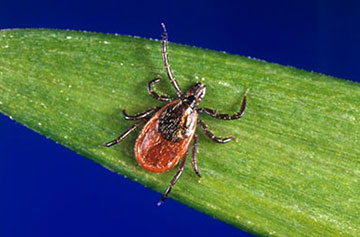Originally posted on the BEEF Newsletter, By: Timothy McDermott DVM, OSU Extension Educator, Franklin County
There has been an increase in tick-vectored diseases in Ohio to livestock, companion animals and humans over the last several years. This has occurred as the different tick species that inhabit Ohio have increased their habitat range and gradual spread from the south and east towards the north. The increase in awareness of tick-vectored diseases is now only starting to catch up as a public and livestock health awareness priority.
 Despite an increase in tick-vectored diseases throughout Ohio, it’s common to believe that ticks such as this deer tick are only present during spring or summer.
Despite an increase in tick-vectored diseases throughout Ohio, it’s common to believe that ticks such as this deer tick are only present during spring or summer.
Ticks have been found to vector not only bacterial diseases, but new-vectored viral diseases as well as allergic reactions have increased in frequency and severity. As the producer gets ready for spring production work, they have multiple potential chances to interact with ticks. This might include inspecting fence for post-winter repair, checking on spring calving, walking pasture to evaluate forage stands or moving cattle to different paddocks to take advantage of lush spring growth. Understanding tick habitat preferences, knowing what life cycle stages are present and making a personal protective biosecurity plan will allow the producer todecrease their chances of a tick-vectored disease concern.
The ticks of consequence in Ohio are hard shell ticks, in the Animal Kingdom, Phylum Arthropods, Class Arachnids, and Subclass Acari. This means that they are related to spiders. They do not fly and use a hunting method called “questing” where they use their back pair of legs to hold onto vegetation and the front pair of legs to grab prey as it passes by. This is useful information for prevention as you encounter a tick when you enter the habitat they prefer.
The main Ohio tick species are the Brown Dog Tick, the American Dog Tick, the Blacklegged or Deer Tick and the Lone Star Tick. A common misconception about ticks is that they are only present during spring or summer. Most ticks have a one-year life cycle, except Blacklegged (Deer) ticks, which have a two-year life cycle. Different growth stages are more active during different times of the year. Right now in Ohio according to tickencounter.org, the ticks that are most prevalent are adult American Dog ticks and adult Blacklegged ticks. As the spring progresses to summer, the Lone Star Tick will increase in frequency.
Each tick species has its preferred habitat and individual characteristics. The preferred habitat of the American Dog Tick is pasture grasses and meadows while the preferred habitat for Blacklegged ticks are dense woodlands. The current adult stages will look to feed on larger mammals such as deer, cattle, small ruminants, horses and humans. It is important for the producer who will enter tick habitat to have a personal protection plan to prevent tick attachment and potential disease transmission. Producers should wear long pants and shirts, preferable light colored to be able to see the ticks. The preferred repellant strategy is to wear permethrin treated clothing, as this will repel ticks when they are questing to find blood meal sources. Clothing can be purchased already treated from major outdoor or work clothing suppliers as well as clothing can be treated at home using a permethrin spray or concentrate labelled for use on clothing. Should a producer find an embedded tick on their person, the tick should be removed and saved as ticks can now be tested to see if they carry infectious disease. Details on how to treat clothing with permethrin, correct tick removal as well as laboratories that will test ticks for disease can be found at tickencounter.org.
A prevention strategy for tick disease in livestock is challenging. Treating a pasture for ticks is not feasible and full daily close visual examination of a herd is difficult in many grazing systems. A producer should try to keep pasture fence lines mowed to suppress weeds and shrubby habitat and try to minimize exposure of livestock to wild animals who are the preferred blood meal for ticks. It is important for a producer to make a plan to deal with potential tick encounters when working their livestock. Having a personal biosecurity plan for repellant clothing, removal strategies, and post-pasture tick checks are critical to keep the producer safe and decrease the chances of tick-vectored disease. If a producer suspects a tick-vectored disease is present in one of their animals, they should contact their veterinarian immediately.
